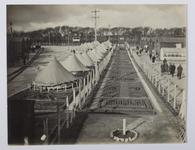The contents consists of two hand written journals from Douglas Alien Detention Camp (September 1914 - June 1916 and June 1916 - February 1919) which record the daily activities of the camp and the internees. Content includes the recording of the arrival and release of internees, visits by officials and daily life within the camp (including the November 1914 riot). The final item includes one register of documents received and notes of action taken (1915-1917).
Douglas Alien Detention Camp records
This material is held atManx National Heritage Library and Archives
- Reference
- IM 147 MS 06465
- Alternative Id.IM 147 MD 15028/1-3
- Dates of Creation
- 1914-1919
- Name of Creator
- Language of Material
- English
- Physical Description
- 3 volumes
- Digital Content
Scope and Content
Administrative / Biographical History
During the First World War the Isle of Man was used as an internment base for civilian 'enemy aliens'. The first camp established was at Cunningham's Holiday Camp, Douglas. Cunningham's was a holiday camp where thousands of young, single male holiday makers camped in tents at their leisure. It was founded in the 1890s by Joseph Cunningham (1853-1924) and his wife Elizabeth née Harley (1864-1939). The original setting was in the east coastal village of Laxey before moving to Howstrake overlooking Groudle Glen. In 1904 the Cunninghams acquired five acres of agricultural land at Victoria Road, Douglas, and moved the camp to the capital. Some 1,500 tents and a 100 foot dining pavilion were erected to accommodate the male visitors.
Soon after the outbreak of the First World War the camp was requisitioned for internment purposes and by September 1914 the first batch of civilian enemy aliens arrived on the Island. Renamed Douglas Alien Detention Camp, the all-male internees were a mixed group and ranged from the extremely poor to the very educated and wealthy. The camp was later split into three sections: there was a privilege camp for those who could afford to pay for extra facilities (and also employ an internee servant), a Jewish camp where kosher food and facilities for celebrating Jewish festivals were provided and an ordinary camp for the rest of the civilian aliens. The camp Commandant was Colonel Henry William Madoc (1870-1937), the Island's Chief Constable.
By late October 1914 there were approximately 2,600 men in the Douglas camp, which temporarily increased to 3,300 after alleviating congestion from other internment camps in London. Overcrowding, boredom and complaints about the poor quality of food led to a riot in November 1914, during which five internees were shot and killed. A subsequent inquest found the actions of the guards justifiable and forced upon them by the riotous conduct of the internees. After the inquest it was quickly decided that a bigger internment camp was needed, the outcome being the construction of Knockaloe Alien Detention Camp, situated on the west coast of the Island. Knockaloe was far bigger than Douglas; it had four sub-camps within its barbed wire compound and by the end of the war it housed over 20,000 men. Throughout the men's confinement (at Douglas and Knockaloe) they were allowed to wear their own clothes and have personal items such as books. Over time the camps started workshops, produced works of art, set up theatrical groups and set up a school. In November 1918 armistice was declared and the war was over. By 1919 all Douglas internees were released and Cunningham's Holiday Camp was back in business for the 1919 summer season.
Access Information
No regulations or restrictions are implemented on this material.
Advance notification of a research visit is advisable by emailing library@mnh.gov.im .
Archivist's Note
The biographical information was gathered from Yvonne M Cresswell's (ed.) Living With the Wire: Civilian Internment in the Isle of Man During the Two World Wars (2010: 7-13) and the website http://isle-of-man.com/manxnotebook/tourism/ccamp/index.htm (accessed 11 July 2016).
Fonds-level description created by Eleanor Williams (MNH Project Archivist), July 2016.

